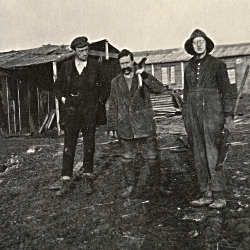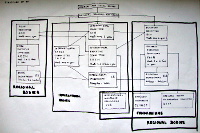Service Civil International
'Structure of SCI' diagram, mid-1980s
by Heinz Gabathuler (Oct 17, 2016)
In one of the many boxes I got from the IS two years ago, I found this sober sheet of paper in DIN A3 format, containing a diagram that shows all relevant international bodies of SCI in handdrawn rectangles and their relations in various lines, also drawn by hand.
The photocopied document does not indicate a date or year, but from the content it becomes clear that it must have been created between 1986 when the International Secretariat (IS) moved from Canterbury in England to Bangalore in India (quite in the centre of the diagram) and 1991 when the Commission for Cooperation with Youth Movements in Socialist Countries (CCYMSC), bottom right in the diagram, was transformed into the Group of Action Together in Europe (GATE), following the disapperance of the so-called 'Socialist Countries' (SC) and the distance SCI took from some of their so-called 'Youth Movements' (YM). There is one paradox, however, as the NICC (bottom, further right than the CCYMSC, in the diagram) seemed to have replaced by IVS Northern Ireland already in 1985, as can be easily discovered when checking in the Archives catalogue. The same applies to the International Africa Committee, an indirect precursor of the nowadays Africa Working Group. I therefore assume that the diagram had been drawn exactly when the move of the IS had been decided, and maybe this move has been the trigger for creating it: To give provide newcomers with a tool that made it easier for them to understand the (dys-)functioning of this movement so wonderful and hard-to-understand at the same time. Everything, including the text, was written and drawn by hand, as in the mid-1980s, most of humankind had not yet been enlightened by easy-going graphic design software.
The diagram shows, first and foremost, how complex the international structures of SCI had been at that time. The lack of arrows or other design elements aimed at specifying the exact relationship, or interaction, between the various rectangles, may be due to exactly that complexity (too much of a challenge for the designer?!) – or maybe the simple, arrowless lines also send out the message that within SCI there is no hierarchy whatsoever between all these elements but just simple interaction? (Which of course would not have been true: Back then, just like nowadays, ICM elected the IEC, and IS was accountable to IEC – and the same applies to the regional structures in both Asia and Europe.)
Furthermore, the diagram shows us how much different SCI formal structures have been just 30 years ago: The 'Regional Bodies' in Asia and Europe had been abolished. The then European Secretariat in Antwerpen has been upgraded to the one and only International Secretariat. Commissions have been replaced by Working Groups. And one wonders, how branches and their volunteers and staffpersons could afford to attend all these ICMs (just every 2 years, however), ACMs, ECMs, and what might have been the topics discussed at these meetings. And if the way how their respective fruitfulness, and the climate of the formal and less formal parts of these gatherings were perceived by the participants had been much different from nowadays.
And one more thought comes to my mind, looking at the document: The irony that the most important 'institutions' in our grassroots-based volunteer movement – local groups and branches – are only mentioned on the very top and – even more ironic – outside of all the big boxes. And the question whether the authors of the drawing were aware of it. The term 'workcamp', by the way, does not appear at all. In this 'structure' of SCI, workcamps simply have no place. Good old Pierre Ceresole would not like that at all, I am sure…
Â
Heinz Gabathuler, International Archives Coordinator
Reference
This irresistibly cute piece of paper will most likely end up in box 40050 International Constitutions and Constitutional Documents in the International Archives.




 Click to enlarge image
Click to enlarge image